
Medieval Muslim Algeria was a period of Muslim dominance in Algeria during the Middle Ages, spanning the millennium from the 7th century to the 17th century. The new faith, in its various forms, would penetrate nearly all segments of society, bringing with it armies, learned men, and fervent mystics; in large part, it would replace tribal practices and loyalties with new social norms and political idioms.
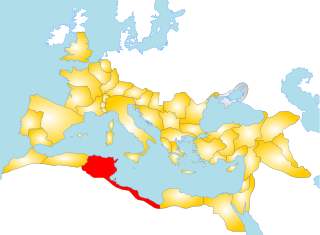
Ifriqiya, also known as al-Maghrib al-Adna, was a medieval historical region comprising today's Tunisia and eastern Algeria, and Tripolitania. It included all of what had previously been the Byzantine province of Africa Proconsularis and extended beyond it, but did not include the Mauretanias.
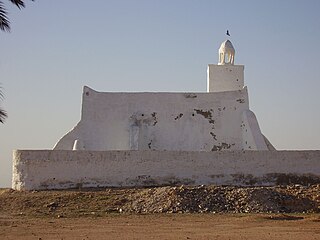
The Ibadi movement or Ibadism is a school of Islam. It has been called by some the third branch of Islam, along with Sunni Islam and Shia Islam. The followers of Ibadism are known as the Ibadis.
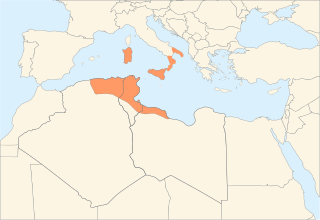
The Aghlabids were an Arab dynasty centered in Ifriqiya from 800 to 909 that conquered parts of Sicily, Southern Italy, and possibly Sardinia, nominally as vassals of the Abbasid Caliphate. The Aghlabids were from the Najdi tribe of Banu Tamim and adhered to the Mu'tazilite rationalist doctrine within Hanafi Sunni Islam, which they imposed as the state doctrine of Ifriqiya. They ruled until 909 when they were conquered by the new power of the Fatimids.
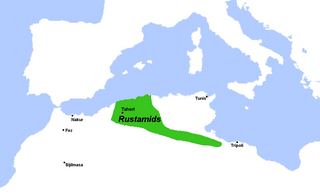
The Rustamid dynasty was an Ibadi Persian dynasty centered in present-day Algeria. The dynasty governed as a Muslim theocracy for a century and a half from its capital Tahert until the Ismaili Fatimid Caliphate defeated it. Rustamid authority extended over what is now central and western Algeria, parts of southern Tunisia, and the Jebel Nafusa and Fezzan regions in Libya as far as Zawila.

Abū Yazīd Makhlad ibn Kaydād, also known as the Man on the Donkey, was an Ibadi Berber of the Banu Ifran tribe who led a rebellion against the Fatimid Caliphate in Ifriqiya starting in 944. Abu Yazid conquered Kairouan for a time, but was eventually driven back and defeated by the Fatimid caliph al-Mansur bi-Nasr Allah.
ʿAbd al-Raḥmān ibn Ḥabīb al-Fihrī was an Arab noble of the Fihrid family, and ruler of Ifriqiya from 745 through 755 AD.
The Berber Revolt or the Kharijite Revolt of 740–743 AD took place during the reign of the Umayyad Caliph Hisham ibn Abd al-Malik and marked the first successful secession from the Arab caliphate. Fired up by Kharijite puritan preachers, the Berber revolt against their Umayyad Arab rulers began in Tangiers in 740, and was led initially by Maysara al-Matghari. The revolt soon spread through the rest of the Maghreb and across the straits to al-Andalus.
The Berbers are an indigenous ethnic group of the Maghreb region of North Africa. Following the Muslim conquest of the Maghreb, most Berber tribes eventually became Muslims. Presently, about one-sixth of the population of Maghreb speaks one of the Berber languages, but most of them also speak some form of Arabic. Berbers are the first non-Arab people to have established an Islamic state.

The History of early Islamic Tunisia opens with the arrival of the Arabs who brought their language and the religion of Islam, and its calendar. The Arab conquest followed strategy designed by the Umayyad Caliphate regarding its long-term conflict with the Byzantine Empire. The native Berbers eventually converted to Islam. They might have seen some similarities between themselves and the Arabs, in similar cognate culture, such as familiarity with a pastoral way of life. The first local Islamic ruling house, the Aghlabids, consisted primarily of rule by leading members of this Arab tribe. Fundamental elements of Islamic civilization were established. Although accepting Islam, many Berbers nonetheless resisted rule by the Arabs, establishing the Rustamid kingdom following the Kharijite revolt. Next in Ifriqiya (Tunisia) arose the Shia Fatimids, inspired by a few immigrants from the east yet consisting for the most part of Ifriqiya Berbers. The Fatimids later expanded their rule east, through conquest by Berber armies of Egypt, and established their caliphate there which came to include Syria and the Hejaz.
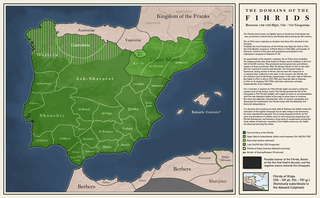
The Fihrids, also known as Banu Fihr, were an Arab family and clan, prominent in North Africa and Al-Andalus in the 8th century.
Handhala ibn Safwan al-Kalbi was an Umayyad governor of Egypt from 721 to 724 and again 737 to 742, and subsequently governor of Ifriqiya from 742 to 745.
Ilyas ibn Habib al-Fihri was an Arab noble of the Oqbid or Fihrid family, and briefly ruler of Ifriqiya in 755.
Habib ibn Abd al-Rahman al-Fihri was an Arab noble of the Oqbid or Fihrid family, and briefly ruler of Ifriqiya from 755 to 757.
Abd al-Rahman ibn Rustam was a Persian imam and the founder of Rustamid dynasty, which existed in Algeria from about 776 or 778 CE to 908 CE. He was also the founder of Tiaret.
Muhammad ibn al-Ash'ath al-Khuza'i was an early Abbasid follower and later became Abbasid governor in Iran, Egypt and Ifriqiya for the Abbasid Caliphate.
The Ifranid Emirate of Tlemcen or Ifranid Kingdom of Tlemcen, was a Kharijite state, founded by Berbers of the Banu Ifran in the eighth century, with its capital at Tlemcen in modern Algeria.
Umayyad rule in North Africa or Umayyad Ifriqiya was a province of the Umayyad Caliphate (661–750) during the historical period in which it ruled the Maghreb region of North Africa, from its conquest of the Maghreb starting in 661 to the Kharijite Berber Revolt ending in 743, which led to the end of its rule in the western and central Maghreb. Following this period, the Umayyads retained their rule over Ifriqiya while the rest of the Maghreb fell to successive Islamic dynasties of Arab, Berber and Persian descent.

The Malikization of the Maghreb was the process of encouraging the adoption of the Maliki school of Sunni Islam in the Maghreb, especially in the 11th and 12th centuries, to the detriment of Shia and Kharijite inhabitants of the Maghreb. The process occurred as Maliki scholars increasingly gained influence, resulting in the widespread acceptance of the Maliki legal school and the subsequent marginalization of other forms of Islam. Malikism was considered a more conservative and mainstream variant of Sunni Islam.








